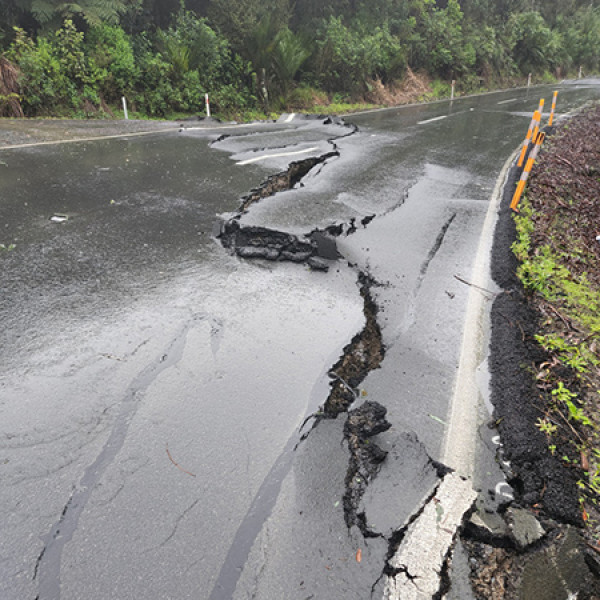
Multiple significant weather-related slips closed SH1 Mangamuka Gorge in August 2022. Waka Kotahi is working to keep people moving on the Far North roading network now and in the future. We’re aiming to create resilient roads which will better withstand weather events and environmental factors.
The official detour route is via SH10 and may add up to 40 minutes to your journey. This route is safe for all vehicles, including heavy and freight vehicles.
The Twin Coast Discovery Route is also open and provides a scenic alternative. This route is only suitable for light vehicles and campervans.
Plan your journey by using the Waka Kotahi Journey Planner:
Journey Planner – Northland(external link)

A programme of works to repair the 15 critical slips along SH1 Mangamuka Gorge has been confirmed, following $100M of funding announced at the end of 2022 and a construction contract awarded in late-February 2023.
Weather events throughout 2023 have caused additional slips within the site area, adding complications to existing slip sites and subsequently creating delays to the programme.
With these conditions, we have reassessed our programme and we are now expecting the road to re-open in late 2024. Repairs will continue as planned to improve safety for road users along State Highway 1 Mangamuka Gorge.
We will continue to keep Far North communities updated as the work progresses and will collaborate with hapū, iwi, community representatives, and members of the freight industry about long-term resilience thinking.
The Far North State Highway Resilience Programme will provide a reliable, resilient, and safe State Highway network to connect the Far North District with the rest of Te Tai Tokerau Northland and Aotearoa New Zealand.
The Programme comprises long-term resilience planning with considerations for State Highway 1 (SH1) Mangamuka, State Highway 10 (SH10) and local roads following the SH1 Mangamuka Gorge closure in August 2022.
It also includes emergency work in the Mangamuka Gorge to prevent further damage and on SH10 to ensure that it is working efficiently to accommodate the additional vehicles with SH1 Mangamuka Gorge closed.
CloseA reliable and resilient roading network is essential to ensure that whānau, friends, businesses and communities stay connected. This is especially important for communities in the Far North where in many places, people live rurally and rely on state highways to get where they’re going safely.
SH1 near Mangamuka Gorge closed in August 2022 for the second time in two years due to significant slip damage caused by severe weather.
We have begun repair work on the 15 critical slips which were a result of the August 2022 event. As part of the repair, we’ll be making the ground less susceptible to slips by improving the drainage through the gorge, so it’s more suitably equipped to handle the increase in severity and frequency of weather events.
With climate change causing more frequent and severe weather events across the country, as well as the sensitive geology through the Maungataniwha Ranges, the Mangamuka Gorge is facing a long-term resilience issue.
Waka Kotahi is working alongside key partners including hapū, local stakeholders and key experts to review the roles of SH1, SH10 and local roads (including Broadwood/Herekino) to provide a resilient network.
Discussions with these partners and key stakeholders will help to confirm the approach to the long-term resilience solutions needed, including examining options, assessing costs and scoping risks.
We are taking a collaborative approach, utilising the extensive knowledge that Far North community representatives and experts hold to help determine our next steps.
CloseEmergency Response – completed
Recovery
Rebuild
To find out more about the Mangamuka Gorge and the work we’ll be carrying out, more information is available below.

Progress highlights since the August 2023 flyover includes that we’re now working on 13 of the 15 critical slips and piling is nearing completion on several of the slips.
Work at the SH1 Mangamuka site has been progressing well in recent months with drier weather,. The teams are constantly looking at ways we can safely improve our programme, with the road expected to re-open in late 2024.
CloseThe weather event in August 2022 resulted in 15 critical slips with almost all requiring a complex engineering solution. Further weather events in 2023 caused additional slips within the site area, adding complications to existing slip sites and subsequently creating delays to the programme.
Each slip will take on average 5-6 months each to repair.
This means there will be multiple work sites operating in parallel in an already constrained environment.
The movement of people, large machinery and materials around site needs to be carefully planned. We are working as quickly as possible while also looking out for the safety of our people and maintaining the integrity of the road.
We accelerated pre-construction work including securing the required funding, designing the complex repair plans, and mobilising the people and equipment needed to carry out the work.
CloseIn heavy rain or during severe weather events, our people will stop work as it is not safe to work in very wet conditions, especially in a constrained and unstable environment like the gorge.
We continually monitor and assess weather conditions to ensure the safety of our people and to maintain the integrity of the road to ensure no further damage occurs.
CloseBoth options would require significant investment.
On average, the state highway through Mangamuka Gorge carries only about 1300 vehicles per day, as compared to somewhere like the Brynderwyn Hills, which carries around 10,000. This means the business case for such a large investment would not meet the criteria for Waka Kotahi funding.
We are investigating other longer-term solutions to ensure the Far North roading network can better withstand future weather events and improve resilience of the roading network in the region.
We understand that SH1 through the area is a social and economic lifeline, and we are committed to ensuring it is resilient for the Far North Communities who rely on it.
Close